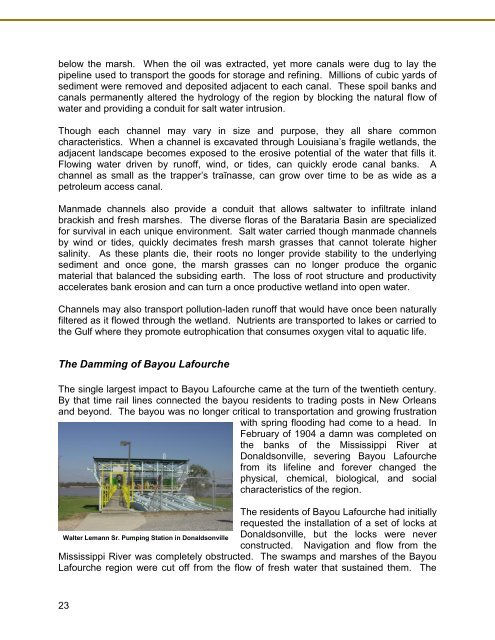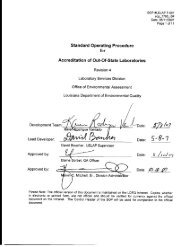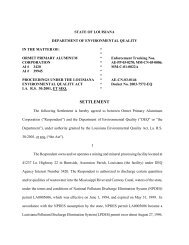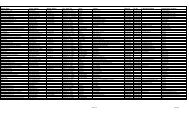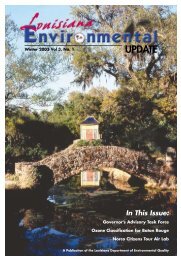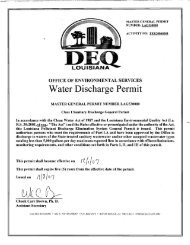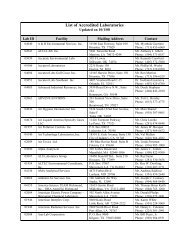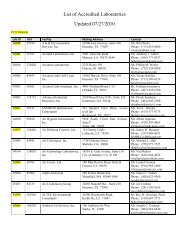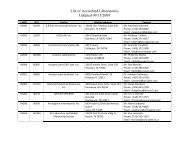Bayou Lafourche
Bayou Lafourche - LDEQ Nonpoint 319 Projects
Bayou Lafourche - LDEQ Nonpoint 319 Projects
- No tags were found...
Create successful ePaper yourself
Turn your PDF publications into a flip-book with our unique Google optimized e-Paper software.
elow the marsh. When the oil was extracted, yet more canals were dug to lay the<br />
pipeline used to transport the goods for storage and refining. Millions of cubic yards of<br />
sediment were removed and deposited adjacent to each canal. These spoil banks and<br />
canals permanently altered the hydrology of the region by blocking the natural flow of<br />
water and providing a conduit for salt water intrusion.<br />
Though each channel may vary in size and purpose, they all share common<br />
characteristics. When a channel is excavated through Louisiana’s fragile wetlands, the<br />
adjacent landscape becomes exposed to the erosive potential of the water that fills it.<br />
Flowing water driven by runoff, wind, or tides, can quickly erode canal banks. A<br />
channel as small as the trapper’s traĩnasse, can grow over time to be as wide as a<br />
petroleum access canal.<br />
Manmade channels also provide a conduit that allows saltwater to infiltrate inland<br />
brackish and fresh marshes. The diverse floras of the Barataria Basin are specialized<br />
for survival in each unique environment. Salt water carried though manmade channels<br />
by wind or tides, quickly decimates fresh marsh grasses that cannot tolerate higher<br />
salinity. As these plants die, their roots no longer provide stability to the underlying<br />
sediment and once gone, the marsh grasses can no longer produce the organic<br />
material that balanced the subsiding earth. The loss of root structure and productivity<br />
accelerates bank erosion and can turn a once productive wetland into open water.<br />
Channels may also transport pollution-laden runoff that would have once been naturally<br />
filtered as it flowed through the wetland. Nutrients are transported to lakes or carried to<br />
the Gulf where they promote eutrophication that consumes oxygen vital to aquatic life.<br />
The Damming of <strong>Bayou</strong> <strong>Lafourche</strong><br />
The single largest impact to <strong>Bayou</strong> <strong>Lafourche</strong> came at the turn of the twentieth century.<br />
By that time rail lines connected the bayou residents to trading posts in New Orleans<br />
and beyond. The bayou was no longer critical to transportation and growing frustration<br />
with spring flooding had come to a head. In<br />
February of 1904 a damn was completed on<br />
the banks of the Mississippi River at<br />
Donaldsonville, severing <strong>Bayou</strong> <strong>Lafourche</strong><br />
from its lifeline and forever changed the<br />
physical, chemical, biological, and social<br />
characteristics of the region.<br />
The residents of <strong>Bayou</strong> <strong>Lafourche</strong> had initially<br />
requested the installation of a set of locks at<br />
Walter Lemann Sr. Pumping Station in Donaldsonville<br />
Donaldsonville, but the locks were never<br />
constructed. Navigation and flow from the<br />
Mississippi River was completely obstructed. The swamps and marshes of the <strong>Bayou</strong><br />
<strong>Lafourche</strong> region were cut off from the flow of fresh water that sustained them. The<br />
23


